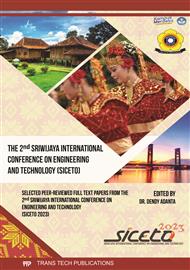[1]
I. R. Mangangka, "Understanding Water Sensitive Urban Design (Wsud) Concept," p.14, 2018.
Google Scholar
[2]
Y. Kassa, "Recent Advances in Application of Constructed Wetland Technologies for Enhanced Wastewater Treatment," vol. 8, no. 7, p.9, 2019.
Google Scholar
[3]
M. E. Rahman et al., "Design, Operation and Optimization of Constructed Wetland for Removal of Pollutant," IJERPH, vol. 17, no. 22, p.8339, Nov. 2020.
DOI: 10.3390/ijerph17228339
Google Scholar
[4]
X. Li, C. Manman, and B. C. Anderson, "Design and performance of a water quality treatment wetland in a public park in Shanghai, China," Ecological Engineering, vol. 35, no. 1, p.18–24, Jan. 2009.
DOI: 10.1016/j.ecoleng.2008.07.007
Google Scholar
[5]
X.-L. Xie, F. He, D. Xu, J.-K. Dong, S.-P. Cheng, and Z.-B. Wu, "Application of large-scale integrated vertical-flow constructed wetland in Beijing Olympic forest park: design, operation and performance: Application of large-scale IVCW," Water and Environment Journal, vol. 26, no. 1, p.100–107, Mar. 2012.
DOI: 10.1111/j.1747-6593.2011.00268.x
Google Scholar
[6]
K. Gunes, F. Masi, S. Ayaz, B. Tuncsiper, and M. Besiktas, "Domestic wastewater and surface runoff treatment implementations by constructed wetlands for Turkey: 25 years of experience," Ecological Engineering, vol. 170, p.106369, Nov. 2021.
DOI: 10.1016/j.ecoleng.2021.106369
Google Scholar
[7]
R. A. P. Tampubolon, L. Febrina, and I. Mulyawati, "Penurunan Kadar Bod, Cod Dan Tss Pada Air Limbah Domestik Dengan Sistem Constructed Wetland Menggunakan Tanaman Kayu Apu (Pistia Stratiotes L.) Reduction Of Bod, Cod And Tss Levels In Domestic Wastewater With Constructed Wetland System Using Apu Wood Plant (Pistia stratiotes L.)," vol. 2, 2020.
DOI: 10.36441/seoi.v2i1.469
Google Scholar
[8]
"Analisa Luasan CW menggunakan tanaman Iris dalam mengolah air limbah domestik.pdf."
Google Scholar
[9]
A. Amalia, "Degradasi senyawa nitrogen limbah cair pabrik pupuk dengan menggunakan eceng gondok (Eicchornia crassipes (Mart.) Solms)".
Google Scholar
[10]
A. Hasan and S. C. Suprapti, "Pengolahan Limbah Cair Rumah Sakit dengan Metode Lahan Basah Buatan (Constructed Wetland) dan Tanaman Air Typha latifolia," JK, vol. 12, no. 3, p.446, Nov. 2021.
DOI: 10.26630/jk.v12i3.2697
Google Scholar
[11]
A. Safrodin, S. Mangkoedihardjo, and A. Yuniarto, "Desain IPAL Subsurface Flow Constructed Wetland Di Rusunawa Grudo Surabaya," IJPS, vol. 3, no. 5, Nov. 2017.
DOI: 10.12962/j23546026.y2017i5.3138
Google Scholar
[12]
"Treatment Wetlands, Second Edition by Robert H. Kadlec, Scott Wallace (z-lib.org).pdf."
Google Scholar
[13]
M. E. Rahman et al., "Design, Operation and Optimization of Constructed Wetland for Removal of Pollutant," IJERPH, vol. 17, no. 22, p.8339, Nov. 2020.
DOI: 10.3390/ijerph17228339
Google Scholar
[14]
Y. Kassa, "Recent Advances in Application of Constructed Wetland Technologies for Enhanced Wastewater Treatment," vol. 8, no. 7, 2019.
Google Scholar
[15]
K. Gunes, F. Masi, S. Ayaz, B. Tuncsiper, and M. Besiktas, "Domestic wastewater and surface runoff treatment implementations by constructed wetlands for Turkey: 25 years of experience," Ecological Engineering, vol. 170, p.106369, Nov. 2021.
DOI: 10.1016/j.ecoleng.2021.106369
Google Scholar
[16]
I. Arliyani, B. V. Tangahu, and S. Mangkoedihardjo, "Selection of Plants for Constructed Wetlands Based on Climate and Area in the Interest of Processing Pollutant Parameters on Leachate: A Review," IOP Conf. Ser.: Earth Environ. Sci., vol. 835, no. 1, p.012003, Aug. 2021.
DOI: 10.1088/1755-1315/835/1/012003
Google Scholar
[17]
I. Hassan, S. R. Chowdhury, P. K. Prihartato, and S. A. Razzak, "Wastewater Treatment Using Constructed Wetland: Current Trends and Future Potential," Processes, vol. 9, no. 11, p.1917, Oct. 2021.
DOI: 10.3390/pr9111917
Google Scholar
[18]
W. Mardianto, "Pengolahan Limbah Cair Rumah Makan Menggunakan Sistem Kombinasi Abr Dan Wetland Dengan Sistem Kontinyu," JTLLB, vol. 2, no. 1, Aug. 2014.
DOI: 10.26418/jtllb.v2i1.6746
Google Scholar
[19]
R. A. P. Tampubolon, L. Febrina, and I. Mulyawati, "Penurunan Kadar Bod, Cod Dan Tss Pada Air Limbah Domestik Dengan Sistem Constructed Wetland Menggunakan Tanaman Kayu Apu (Pistia Stratiotes L.) Reduction Of Bod, Cod And Tss Levels In Domestic Wastewater With Constructed Wetland System Using Apu Wood Plant (Pistia stratiotes L.)," vol. 2, p.12, 2020.
DOI: 10.36441/seoi.v2i1.469
Google Scholar
[20]
E. N. Hidayah and W. Aditya, "Potensi Dan Pengaruh Tanaman Pada Pengolahan Air Limbah Domestik Dengan Sistem Constructed Wetland," no. 2, p.8.
DOI: 10.31227/osf.io/9gnrk
Google Scholar


